Organisation Theory: Classical, Neoclassical Theories Transitions
VerifiedAdded on 2023/06/14
|8
|2307
|486
Essay
AI Summary
This essay explores organisational theory, contrasting classical and neoclassical management approaches. Classical theory emphasizes efficiency through specialisation and coordination, incorporating scalar processes and structural elements. Neoclassical theory focuses on psychological variables, highlighting social and economic factors and introducing concepts like decentralisation and informal organisation. The essay further discusses modern organisation theory, which integrates internal and external variables, contingency approaches, and contemporary marketing orientations. It also examines the cultural excellence approach, focusing on achieving superior results through strong teams and continuous improvement, as well as the Japanese approach to quality management, which emphasizes human resource development. Finally, the essay touches on organisational learning, highlighting the importance of knowledge creation, retention, and transfer within an organisation to foster growth and development. Desklib offers more resources for students.
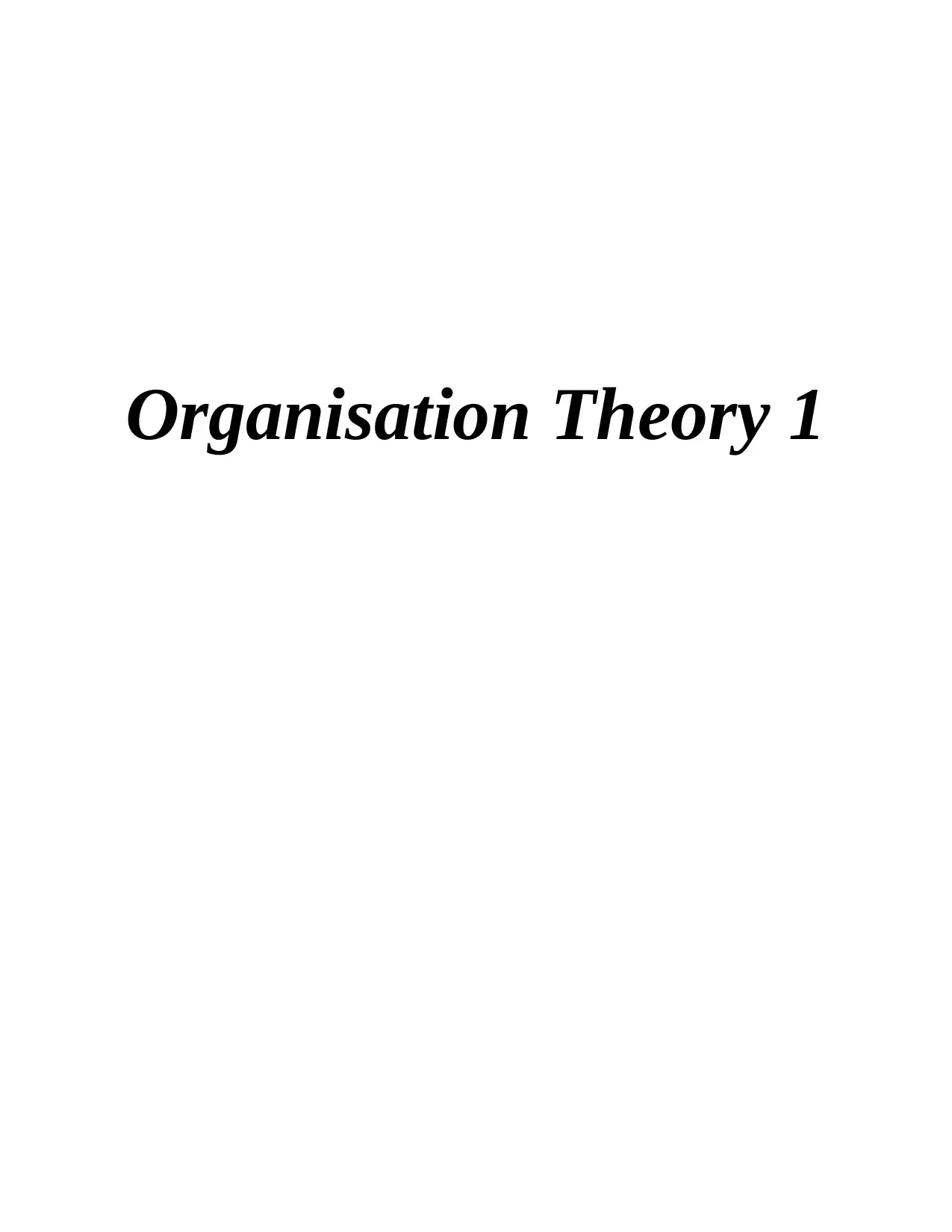
Organisation Theory 1
Paraphrase This Document
Need a fresh take? Get an instant paraphrase of this document with our AI Paraphraser
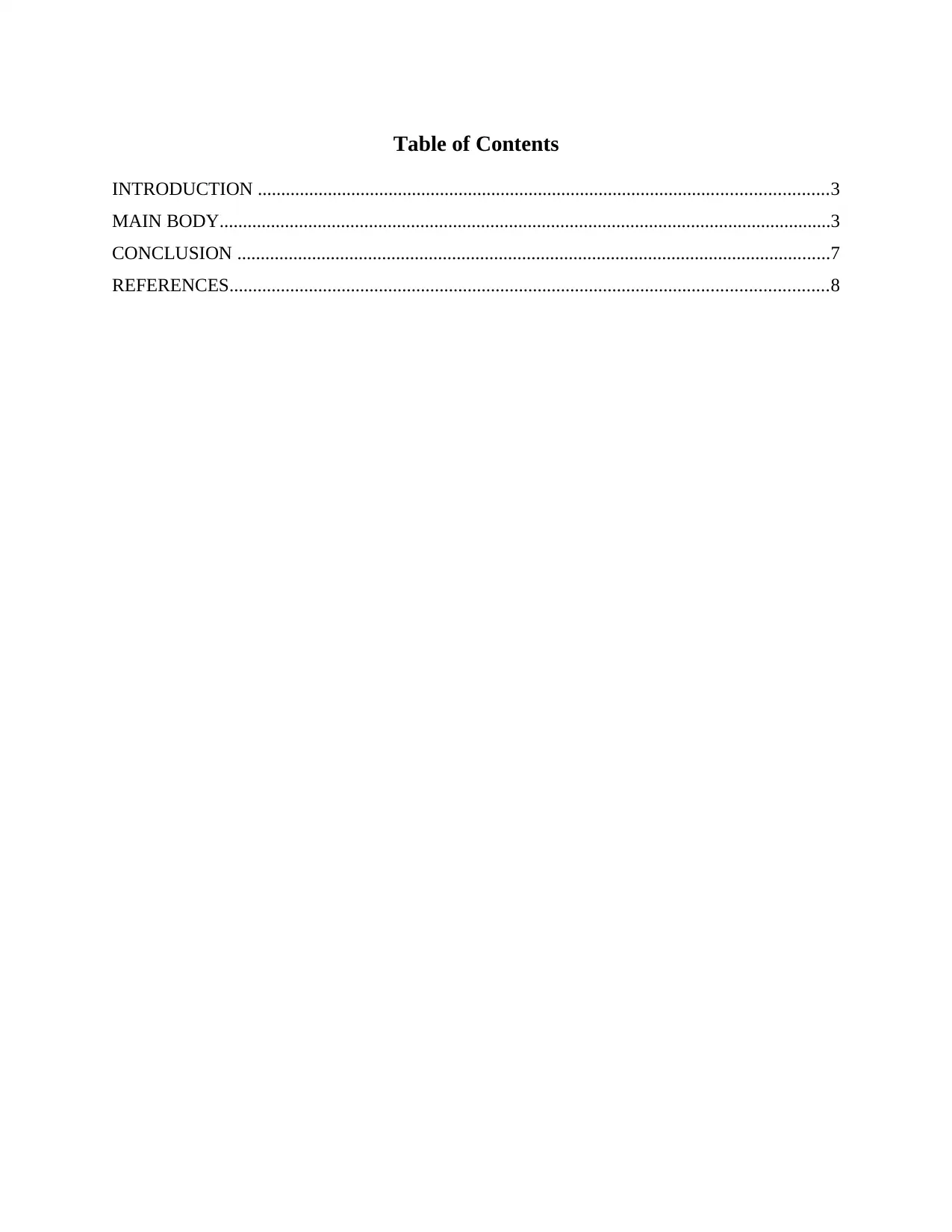
Table of Contents
INTRODUCTION ..........................................................................................................................3
MAIN BODY...................................................................................................................................3
CONCLUSION ...............................................................................................................................7
REFERENCES................................................................................................................................8
INTRODUCTION ..........................................................................................................................3
MAIN BODY...................................................................................................................................3
CONCLUSION ...............................................................................................................................7
REFERENCES................................................................................................................................8
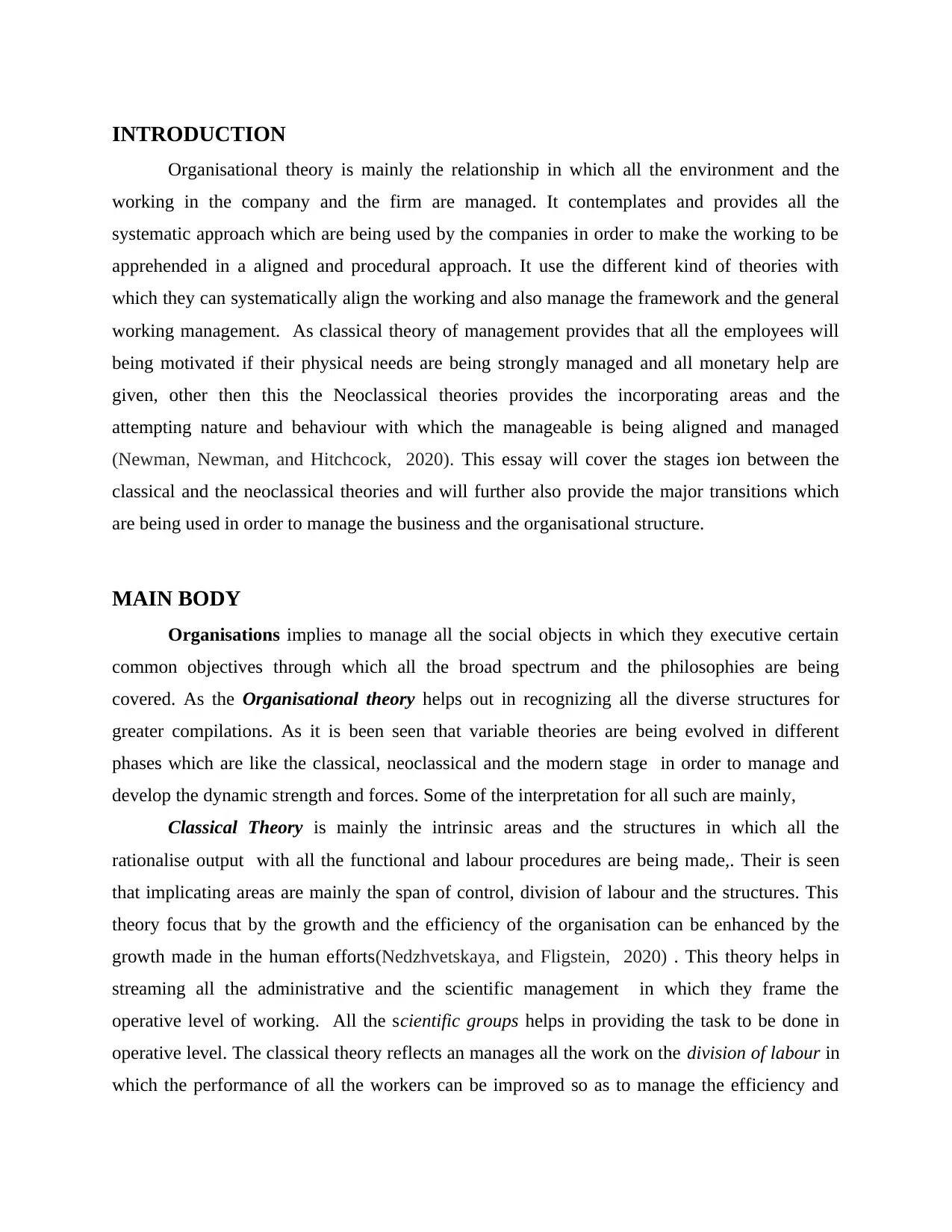
INTRODUCTION
Organisational theory is mainly the relationship in which all the environment and the
working in the company and the firm are managed. It contemplates and provides all the
systematic approach which are being used by the companies in order to make the working to be
apprehended in a aligned and procedural approach. It use the different kind of theories with
which they can systematically align the working and also manage the framework and the general
working management. As classical theory of management provides that all the employees will
being motivated if their physical needs are being strongly managed and all monetary help are
given, other then this the Neoclassical theories provides the incorporating areas and the
attempting nature and behaviour with which the manageable is being aligned and managed
(Newman, Newman, and Hitchcock, 2020). This essay will cover the stages ion between the
classical and the neoclassical theories and will further also provide the major transitions which
are being used in order to manage the business and the organisational structure.
MAIN BODY
Organisations implies to manage all the social objects in which they executive certain
common objectives through which all the broad spectrum and the philosophies are being
covered. As the Organisational theory helps out in recognizing all the diverse structures for
greater compilations. As it is been seen that variable theories are being evolved in different
phases which are like the classical, neoclassical and the modern stage in order to manage and
develop the dynamic strength and forces. Some of the interpretation for all such are mainly,
Classical Theory is mainly the intrinsic areas and the structures in which all the
rationalise output with all the functional and labour procedures are being made,. Their is seen
that implicating areas are mainly the span of control, division of labour and the structures. This
theory focus that by the growth and the efficiency of the organisation can be enhanced by the
growth made in the human efforts(Nedzhvetskaya, and Fligstein, 2020) . This theory helps in
streaming all the administrative and the scientific management in which they frame the
operative level of working. All the scientific groups helps in providing the task to be done in
operative level. The classical theory reflects an manages all the work on the division of labour in
which the performance of all the workers can be improved so as to manage the efficiency and
Organisational theory is mainly the relationship in which all the environment and the
working in the company and the firm are managed. It contemplates and provides all the
systematic approach which are being used by the companies in order to make the working to be
apprehended in a aligned and procedural approach. It use the different kind of theories with
which they can systematically align the working and also manage the framework and the general
working management. As classical theory of management provides that all the employees will
being motivated if their physical needs are being strongly managed and all monetary help are
given, other then this the Neoclassical theories provides the incorporating areas and the
attempting nature and behaviour with which the manageable is being aligned and managed
(Newman, Newman, and Hitchcock, 2020). This essay will cover the stages ion between the
classical and the neoclassical theories and will further also provide the major transitions which
are being used in order to manage the business and the organisational structure.
MAIN BODY
Organisations implies to manage all the social objects in which they executive certain
common objectives through which all the broad spectrum and the philosophies are being
covered. As the Organisational theory helps out in recognizing all the diverse structures for
greater compilations. As it is been seen that variable theories are being evolved in different
phases which are like the classical, neoclassical and the modern stage in order to manage and
develop the dynamic strength and forces. Some of the interpretation for all such are mainly,
Classical Theory is mainly the intrinsic areas and the structures in which all the
rationalise output with all the functional and labour procedures are being made,. Their is seen
that implicating areas are mainly the span of control, division of labour and the structures. This
theory focus that by the growth and the efficiency of the organisation can be enhanced by the
growth made in the human efforts(Nedzhvetskaya, and Fligstein, 2020) . This theory helps in
streaming all the administrative and the scientific management in which they frame the
operative level of working. All the scientific groups helps in providing the task to be done in
operative level. The classical theory reflects an manages all the work on the division of labour in
which the performance of all the workers can be improved so as to manage the efficiency and
⊘ This is a preview!⊘
Do you want full access?
Subscribe today to unlock all pages.

Trusted by 1+ million students worldwide
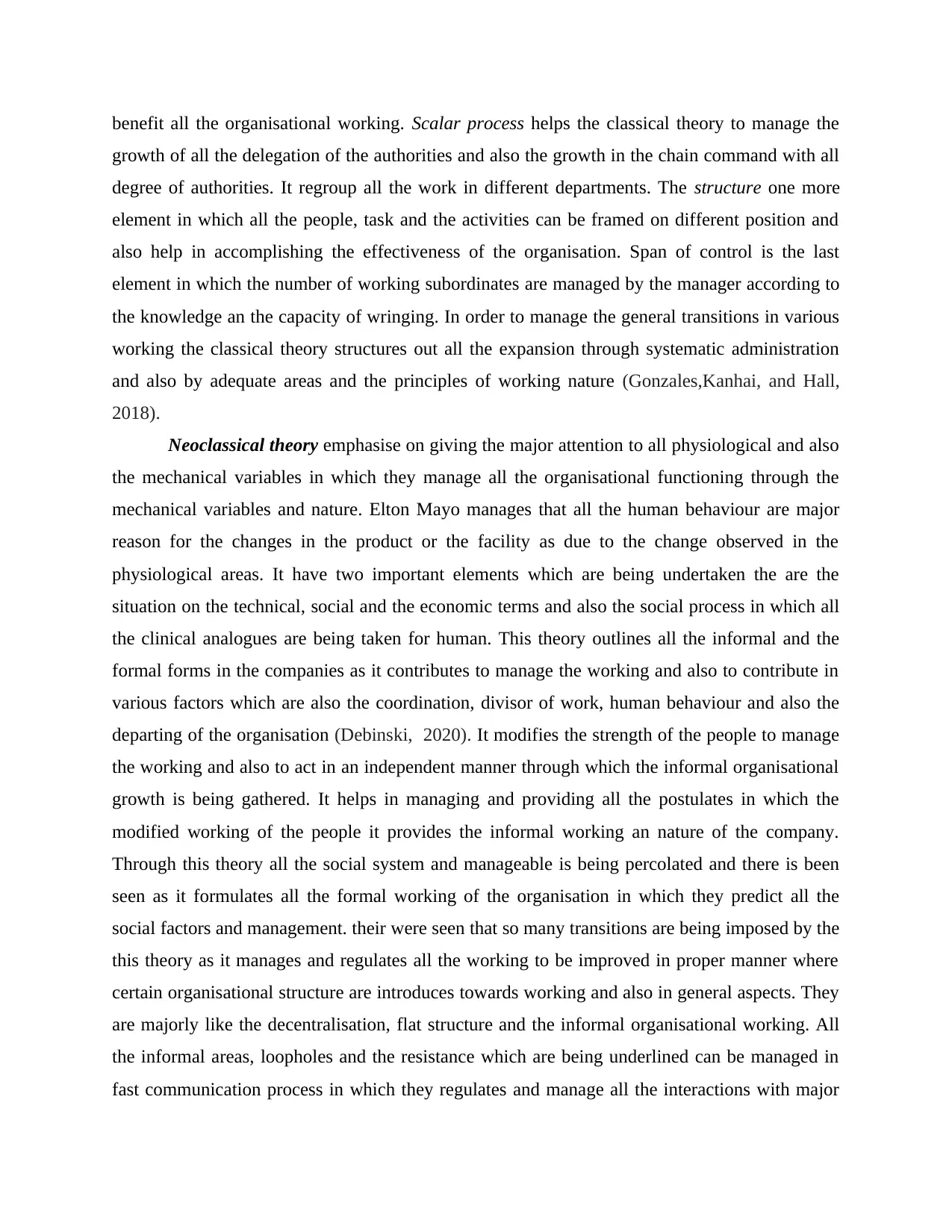
benefit all the organisational working. Scalar process helps the classical theory to manage the
growth of all the delegation of the authorities and also the growth in the chain command with all
degree of authorities. It regroup all the work in different departments. The structure one more
element in which all the people, task and the activities can be framed on different position and
also help in accomplishing the effectiveness of the organisation. Span of control is the last
element in which the number of working subordinates are managed by the manager according to
the knowledge an the capacity of wringing. In order to manage the general transitions in various
working the classical theory structures out all the expansion through systematic administration
and also by adequate areas and the principles of working nature (Gonzales,Kanhai, and Hall,
2018).
Neoclassical theory emphasise on giving the major attention to all physiological and also
the mechanical variables in which they manage all the organisational functioning through the
mechanical variables and nature. Elton Mayo manages that all the human behaviour are major
reason for the changes in the product or the facility as due to the change observed in the
physiological areas. It have two important elements which are being undertaken the are the
situation on the technical, social and the economic terms and also the social process in which all
the clinical analogues are being taken for human. This theory outlines all the informal and the
formal forms in the companies as it contributes to manage the working and also to contribute in
various factors which are also the coordination, divisor of work, human behaviour and also the
departing of the organisation (Debinski, 2020). It modifies the strength of the people to manage
the working and also to act in an independent manner through which the informal organisational
growth is being gathered. It helps in managing and providing all the postulates in which the
modified working of the people it provides the informal working an nature of the company.
Through this theory all the social system and manageable is being percolated and there is been
seen as it formulates all the formal working of the organisation in which they predict all the
social factors and management. their were seen that so many transitions are being imposed by the
this theory as it manages and regulates all the working to be improved in proper manner where
certain organisational structure are introduces towards working and also in general aspects. They
are majorly like the decentralisation, flat structure and the informal organisational working. All
the informal areas, loopholes and the resistance which are being underlined can be managed in
fast communication process in which they regulates and manage all the interactions with major
growth of all the delegation of the authorities and also the growth in the chain command with all
degree of authorities. It regroup all the work in different departments. The structure one more
element in which all the people, task and the activities can be framed on different position and
also help in accomplishing the effectiveness of the organisation. Span of control is the last
element in which the number of working subordinates are managed by the manager according to
the knowledge an the capacity of wringing. In order to manage the general transitions in various
working the classical theory structures out all the expansion through systematic administration
and also by adequate areas and the principles of working nature (Gonzales,Kanhai, and Hall,
2018).
Neoclassical theory emphasise on giving the major attention to all physiological and also
the mechanical variables in which they manage all the organisational functioning through the
mechanical variables and nature. Elton Mayo manages that all the human behaviour are major
reason for the changes in the product or the facility as due to the change observed in the
physiological areas. It have two important elements which are being undertaken the are the
situation on the technical, social and the economic terms and also the social process in which all
the clinical analogues are being taken for human. This theory outlines all the informal and the
formal forms in the companies as it contributes to manage the working and also to contribute in
various factors which are also the coordination, divisor of work, human behaviour and also the
departing of the organisation (Debinski, 2020). It modifies the strength of the people to manage
the working and also to act in an independent manner through which the informal organisational
growth is being gathered. It helps in managing and providing all the postulates in which the
modified working of the people it provides the informal working an nature of the company.
Through this theory all the social system and manageable is being percolated and there is been
seen as it formulates all the formal working of the organisation in which they predict all the
social factors and management. their were seen that so many transitions are being imposed by the
this theory as it manages and regulates all the working to be improved in proper manner where
certain organisational structure are introduces towards working and also in general aspects. They
are majorly like the decentralisation, flat structure and the informal organisational working. All
the informal areas, loopholes and the resistance which are being underlined can be managed in
fast communication process in which they regulates and manage all the interactions with major
Paraphrase This Document
Need a fresh take? Get an instant paraphrase of this document with our AI Paraphraser
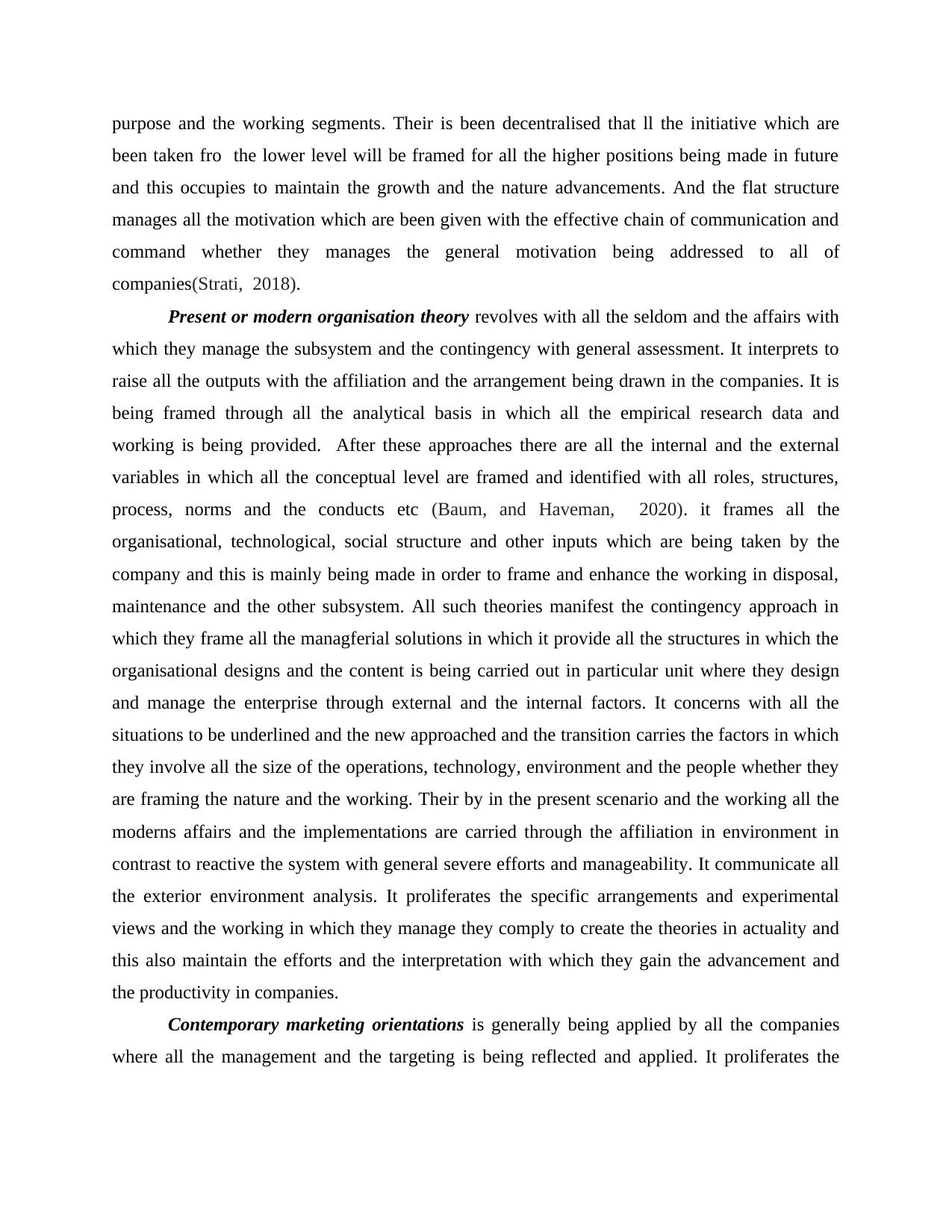
purpose and the working segments. Their is been decentralised that ll the initiative which are
been taken fro the lower level will be framed for all the higher positions being made in future
and this occupies to maintain the growth and the nature advancements. And the flat structure
manages all the motivation which are been given with the effective chain of communication and
command whether they manages the general motivation being addressed to all of
companies(Strati, 2018).
Present or modern organisation theory revolves with all the seldom and the affairs with
which they manage the subsystem and the contingency with general assessment. It interprets to
raise all the outputs with the affiliation and the arrangement being drawn in the companies. It is
being framed through all the analytical basis in which all the empirical research data and
working is being provided. After these approaches there are all the internal and the external
variables in which all the conceptual level are framed and identified with all roles, structures,
process, norms and the conducts etc (Baum, and Haveman, 2020). it frames all the
organisational, technological, social structure and other inputs which are being taken by the
company and this is mainly being made in order to frame and enhance the working in disposal,
maintenance and the other subsystem. All such theories manifest the contingency approach in
which they frame all the managferial solutions in which it provide all the structures in which the
organisational designs and the content is being carried out in particular unit where they design
and manage the enterprise through external and the internal factors. It concerns with all the
situations to be underlined and the new approached and the transition carries the factors in which
they involve all the size of the operations, technology, environment and the people whether they
are framing the nature and the working. Their by in the present scenario and the working all the
moderns affairs and the implementations are carried through the affiliation in environment in
contrast to reactive the system with general severe efforts and manageability. It communicate all
the exterior environment analysis. It proliferates the specific arrangements and experimental
views and the working in which they manage they comply to create the theories in actuality and
this also maintain the efforts and the interpretation with which they gain the advancement and
the productivity in companies.
Contemporary marketing orientations is generally being applied by all the companies
where all the management and the targeting is being reflected and applied. It proliferates the
been taken fro the lower level will be framed for all the higher positions being made in future
and this occupies to maintain the growth and the nature advancements. And the flat structure
manages all the motivation which are been given with the effective chain of communication and
command whether they manages the general motivation being addressed to all of
companies(Strati, 2018).
Present or modern organisation theory revolves with all the seldom and the affairs with
which they manage the subsystem and the contingency with general assessment. It interprets to
raise all the outputs with the affiliation and the arrangement being drawn in the companies. It is
being framed through all the analytical basis in which all the empirical research data and
working is being provided. After these approaches there are all the internal and the external
variables in which all the conceptual level are framed and identified with all roles, structures,
process, norms and the conducts etc (Baum, and Haveman, 2020). it frames all the
organisational, technological, social structure and other inputs which are being taken by the
company and this is mainly being made in order to frame and enhance the working in disposal,
maintenance and the other subsystem. All such theories manifest the contingency approach in
which they frame all the managferial solutions in which it provide all the structures in which the
organisational designs and the content is being carried out in particular unit where they design
and manage the enterprise through external and the internal factors. It concerns with all the
situations to be underlined and the new approached and the transition carries the factors in which
they involve all the size of the operations, technology, environment and the people whether they
are framing the nature and the working. Their by in the present scenario and the working all the
moderns affairs and the implementations are carried through the affiliation in environment in
contrast to reactive the system with general severe efforts and manageability. It communicate all
the exterior environment analysis. It proliferates the specific arrangements and experimental
views and the working in which they manage they comply to create the theories in actuality and
this also maintain the efforts and the interpretation with which they gain the advancement and
the productivity in companies.
Contemporary marketing orientations is generally being applied by all the companies
where all the management and the targeting is being reflected and applied. It proliferates the
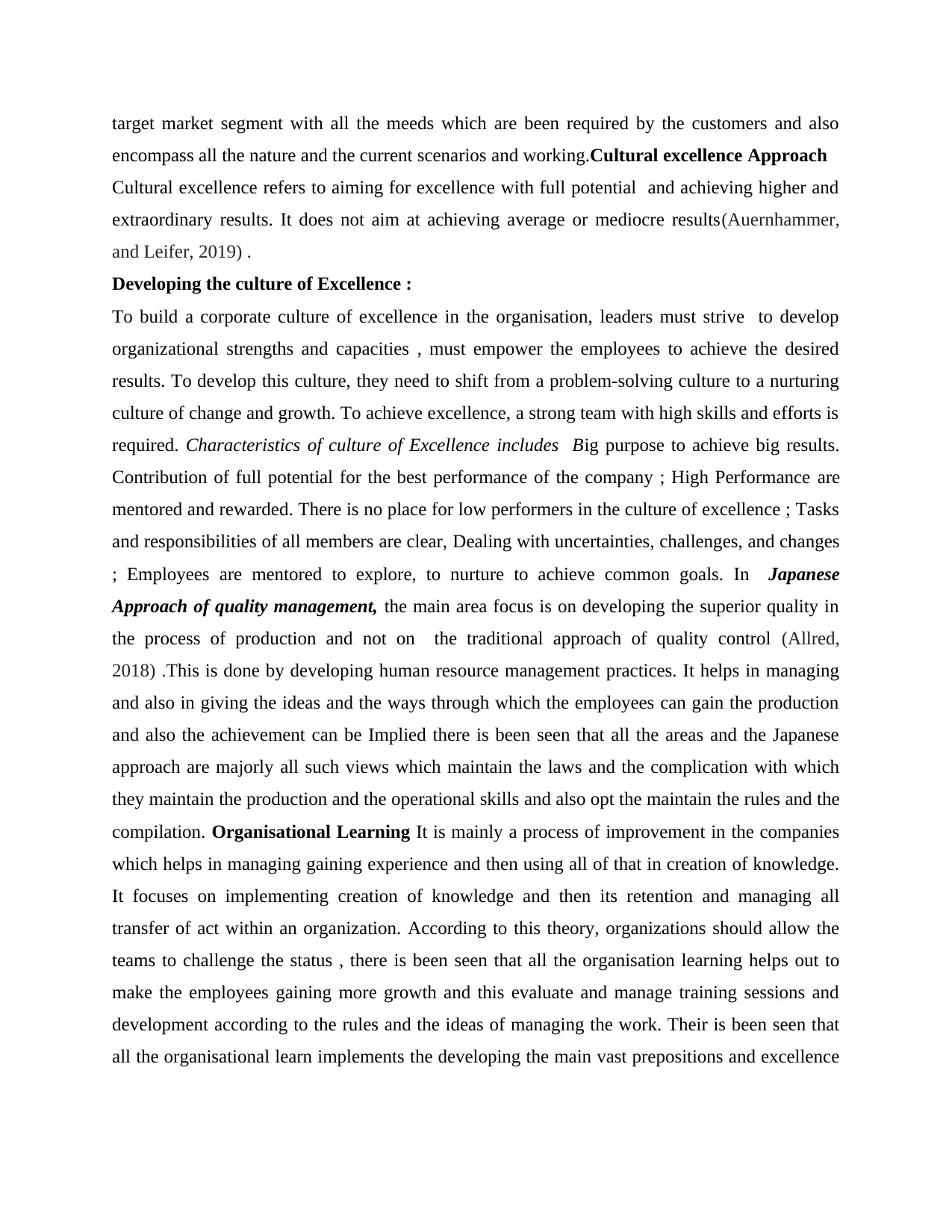
target market segment with all the meeds which are been required by the customers and also
encompass all the nature and the current scenarios and working.Cultural excellence Approach
Cultural excellence refers to aiming for excellence with full potential and achieving higher and
extraordinary results. It does not aim at achieving average or mediocre results(Auernhammer,
and Leifer, 2019) .
Developing the culture of Excellence :
To build a corporate culture of excellence in the organisation, leaders must strive to develop
organizational strengths and capacities , must empower the employees to achieve the desired
results. To develop this culture, they need to shift from a problem-solving culture to a nurturing
culture of change and growth. To achieve excellence, a strong team with high skills and efforts is
required. Characteristics of culture of Excellence includes Big purpose to achieve big results.
Contribution of full potential for the best performance of the company ; High Performance are
mentored and rewarded. There is no place for low performers in the culture of excellence ; Tasks
and responsibilities of all members are clear, Dealing with uncertainties, challenges, and changes
; Employees are mentored to explore, to nurture to achieve common goals. In Japanese
Approach of quality management, the main area focus is on developing the superior quality in
the process of production and not on the traditional approach of quality control (Allred,
2018) .This is done by developing human resource management practices. It helps in managing
and also in giving the ideas and the ways through which the employees can gain the production
and also the achievement can be Implied there is been seen that all the areas and the Japanese
approach are majorly all such views which maintain the laws and the complication with which
they maintain the production and the operational skills and also opt the maintain the rules and the
compilation. Organisational Learning It is mainly a process of improvement in the companies
which helps in managing gaining experience and then using all of that in creation of knowledge.
It focuses on implementing creation of knowledge and then its retention and managing all
transfer of act within an organization. According to this theory, organizations should allow the
teams to challenge the status , there is been seen that all the organisation learning helps out to
make the employees gaining more growth and this evaluate and manage training sessions and
development according to the rules and the ideas of managing the work. Their is been seen that
all the organisational learn implements the developing the main vast prepositions and excellence
encompass all the nature and the current scenarios and working.Cultural excellence Approach
Cultural excellence refers to aiming for excellence with full potential and achieving higher and
extraordinary results. It does not aim at achieving average or mediocre results(Auernhammer,
and Leifer, 2019) .
Developing the culture of Excellence :
To build a corporate culture of excellence in the organisation, leaders must strive to develop
organizational strengths and capacities , must empower the employees to achieve the desired
results. To develop this culture, they need to shift from a problem-solving culture to a nurturing
culture of change and growth. To achieve excellence, a strong team with high skills and efforts is
required. Characteristics of culture of Excellence includes Big purpose to achieve big results.
Contribution of full potential for the best performance of the company ; High Performance are
mentored and rewarded. There is no place for low performers in the culture of excellence ; Tasks
and responsibilities of all members are clear, Dealing with uncertainties, challenges, and changes
; Employees are mentored to explore, to nurture to achieve common goals. In Japanese
Approach of quality management, the main area focus is on developing the superior quality in
the process of production and not on the traditional approach of quality control (Allred,
2018) .This is done by developing human resource management practices. It helps in managing
and also in giving the ideas and the ways through which the employees can gain the production
and also the achievement can be Implied there is been seen that all the areas and the Japanese
approach are majorly all such views which maintain the laws and the complication with which
they maintain the production and the operational skills and also opt the maintain the rules and the
compilation. Organisational Learning It is mainly a process of improvement in the companies
which helps in managing gaining experience and then using all of that in creation of knowledge.
It focuses on implementing creation of knowledge and then its retention and managing all
transfer of act within an organization. According to this theory, organizations should allow the
teams to challenge the status , there is been seen that all the organisation learning helps out to
make the employees gaining more growth and this evaluate and manage training sessions and
development according to the rules and the ideas of managing the work. Their is been seen that
all the organisational learn implements the developing the main vast prepositions and excellence
⊘ This is a preview!⊘
Do you want full access?
Subscribe today to unlock all pages.

Trusted by 1+ million students worldwide

to manage the employees and also their varied learning abilities to be evolved. It helps in giving
training and development to frame the structures working.
CONCLUSION
From this above essay it is concluded that organisational theory is generally all the
applicabilities of the laws with which the nature and the general working can be implied and it
evaluates the administration of work and their effective categorisation and nature of formulated
working. Classical theory implies all the efficiency the companies are being regulated by the
coordination and the specialization of the human activities It has scalar, structure and other
approaches in the work. Their is been seen that the neoclassical theory contemplates all the
psychological variables in which the working and the management is been regulated in general
nature where they frame the social, economic and other elements. Further this essay will cover
the Japanese approach and the organisational learning in which it provides the methods and the
ways thorough which companies can gain success.
training and development to frame the structures working.
CONCLUSION
From this above essay it is concluded that organisational theory is generally all the
applicabilities of the laws with which the nature and the general working can be implied and it
evaluates the administration of work and their effective categorisation and nature of formulated
working. Classical theory implies all the efficiency the companies are being regulated by the
coordination and the specialization of the human activities It has scalar, structure and other
approaches in the work. Their is been seen that the neoclassical theory contemplates all the
psychological variables in which the working and the management is been regulated in general
nature where they frame the social, economic and other elements. Further this essay will cover
the Japanese approach and the organisational learning in which it provides the methods and the
ways thorough which companies can gain success.
Paraphrase This Document
Need a fresh take? Get an instant paraphrase of this document with our AI Paraphraser
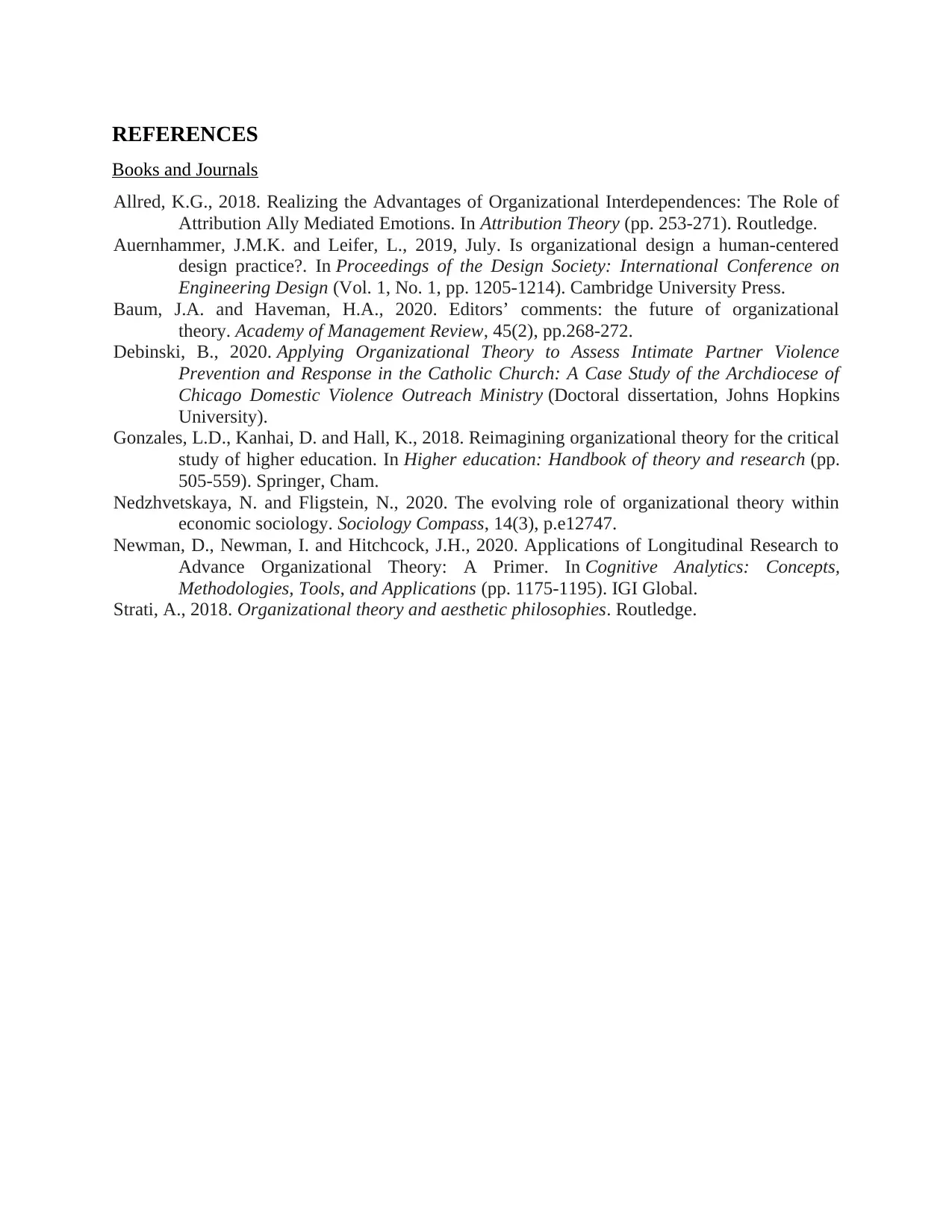
REFERENCES
Books and Journals
Allred, K.G., 2018. Realizing the Advantages of Organizational Interdependences: The Role of
Attribution Ally Mediated Emotions. In Attribution Theory (pp. 253-271). Routledge.
Auernhammer, J.M.K. and Leifer, L., 2019, July. Is organizational design a human-centered
design practice?. In Proceedings of the Design Society: International Conference on
Engineering Design (Vol. 1, No. 1, pp. 1205-1214). Cambridge University Press.
Baum, J.A. and Haveman, H.A., 2020. Editors’ comments: the future of organizational
theory. Academy of Management Review, 45(2), pp.268-272.
Debinski, B., 2020. Applying Organizational Theory to Assess Intimate Partner Violence
Prevention and Response in the Catholic Church: A Case Study of the Archdiocese of
Chicago Domestic Violence Outreach Ministry (Doctoral dissertation, Johns Hopkins
University).
Gonzales, L.D., Kanhai, D. and Hall, K., 2018. Reimagining organizational theory for the critical
study of higher education. In Higher education: Handbook of theory and research (pp.
505-559). Springer, Cham.
Nedzhvetskaya, N. and Fligstein, N., 2020. The evolving role of organizational theory within
economic sociology. Sociology Compass, 14(3), p.e12747.
Newman, D., Newman, I. and Hitchcock, J.H., 2020. Applications of Longitudinal Research to
Advance Organizational Theory: A Primer. In Cognitive Analytics: Concepts,
Methodologies, Tools, and Applications (pp. 1175-1195). IGI Global.
Strati, A., 2018. Organizational theory and aesthetic philosophies. Routledge.
Books and Journals
Allred, K.G., 2018. Realizing the Advantages of Organizational Interdependences: The Role of
Attribution Ally Mediated Emotions. In Attribution Theory (pp. 253-271). Routledge.
Auernhammer, J.M.K. and Leifer, L., 2019, July. Is organizational design a human-centered
design practice?. In Proceedings of the Design Society: International Conference on
Engineering Design (Vol. 1, No. 1, pp. 1205-1214). Cambridge University Press.
Baum, J.A. and Haveman, H.A., 2020. Editors’ comments: the future of organizational
theory. Academy of Management Review, 45(2), pp.268-272.
Debinski, B., 2020. Applying Organizational Theory to Assess Intimate Partner Violence
Prevention and Response in the Catholic Church: A Case Study of the Archdiocese of
Chicago Domestic Violence Outreach Ministry (Doctoral dissertation, Johns Hopkins
University).
Gonzales, L.D., Kanhai, D. and Hall, K., 2018. Reimagining organizational theory for the critical
study of higher education. In Higher education: Handbook of theory and research (pp.
505-559). Springer, Cham.
Nedzhvetskaya, N. and Fligstein, N., 2020. The evolving role of organizational theory within
economic sociology. Sociology Compass, 14(3), p.e12747.
Newman, D., Newman, I. and Hitchcock, J.H., 2020. Applications of Longitudinal Research to
Advance Organizational Theory: A Primer. In Cognitive Analytics: Concepts,
Methodologies, Tools, and Applications (pp. 1175-1195). IGI Global.
Strati, A., 2018. Organizational theory and aesthetic philosophies. Routledge.
1 out of 8
Related Documents
Your All-in-One AI-Powered Toolkit for Academic Success.
+13062052269
info@desklib.com
Available 24*7 on WhatsApp / Email
![[object Object]](/_next/static/media/star-bottom.7253800d.svg)
Unlock your academic potential
Copyright © 2020–2025 A2Z Services. All Rights Reserved. Developed and managed by ZUCOL.





